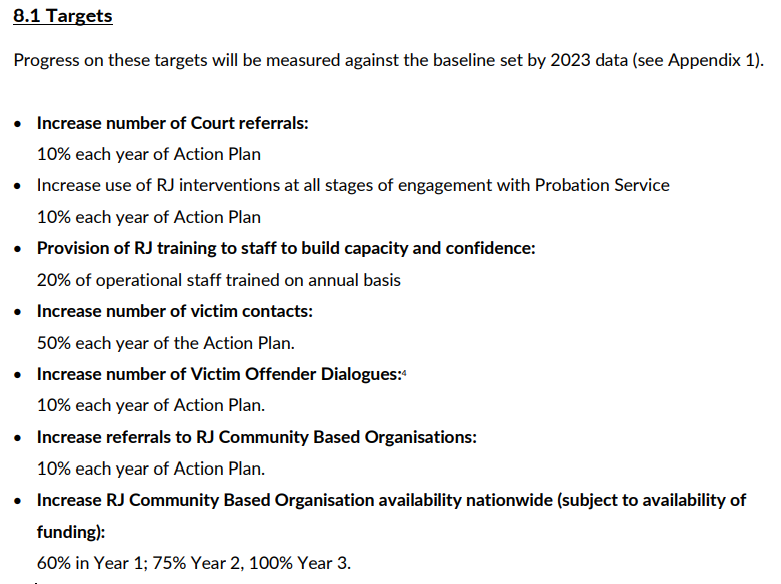Dr Ian Marder: Initial reflections on the Probation Service’s restorative justice action plan

Dr Ian Marder
Dr Ian Marder offers thoughts on the Probation Service’s newly-published restorative justice action plan.
In May, the Probation Service published its Restorative Justice Action Plan for 2025-27. Subtitled Restoring Relationships: Repairing Harm and Empowering Voices through Restorative Justice, the Action Plan marks another important milestone in the development of restorative justice, both in Probation and across Irish criminal justice. It follows the commitment in the 2025 Programme for Government to ‘continue to roll out nationally the voluntary restorative justice programme’.
Building on unpublished Probation Service papers from 2021 and 2022, the Action Plan reflects the Department of Justice’s position that the Government should ‘strengthen existing capabilities [for restorative justice provision] within current structures’. The structures in question include the Probation Service Restorative Justice and Victim Services Unit (RJSVU) and the Probation-funded Community-Based Organisations (CBOs) which deliver restorative justice in particular areas, and at certain stages of the criminal justice process. The Plan states that 15 counties are now served by restorative justice CBOs (p. 9), costing €787,770 in 2024 (p. 20). ‘Scoping work is underway’, it says, ‘to expand provision […] in the North West, Midlands and South West’. This appears to refer to the Expressions of Interest published in October 2024, asking CBOs to apply for dedicated staff to deliver restorative justice in Donegal, the Southwest, and Kilkenny and Carlow.
The Action Plan outlines five work streams, to be led by the RJSVU, as follows:
- Strengthening Internal Capacity
- Expanding National Provision through our CBOs
- Communication and Advocacy
- Developing the Evidence Base
- Advancing RJ in Ireland
Between these five workstreams, the Action Plan provides for 42 actions. While an analysis of all the actions is beyond the scope of this reflection, what follows is my initial analysis of the overall plan and its implications for restorative justice in Ireland. I do this with reference to three themes: a) accessibility, b) whole system collaboration and c) the framing of restorative justice.
Accessibility
The Plan includes targets and actions oriented towards increasing the accessibility of restorative justice. Firstly, it lists accessibility as a principle of restorative justice (p. 4). Secondly, it proposes to increase delivery capacity through the expansion of restorative justice CBOs to counties which do not currently have one, additional resourcing of the RJSVU and greater emphasis on restorative justice in probation practices. Finally, it lists targets to increase court referrals, referrals to CBOs, probation-led practices, victim-offender dialogue and victim contacts (see Fig. 1).

Fig. 1: Targets in the restorative justice action plan (Probation Service, 2025: 7)
This appears to be the first time that restorative justice caseloads have been subject to published targets in Ireland. It is slightly unclear the extent to which these targets overlap and to whom they apply. My understanding is that the Probation Service is responsible for them, including the target of increased CBO referrals; the other targets apply to probation caseloads only. CBOs are subject to key performance indicators in the context of their service-level agreements.
As both CBOs and probation practice expand to new areas, it will be important to map out clearly and transparently the process by which it is decided who will facilitate (or co-work) different types of cases at each stage of the criminal justice process. For example, will CBOs facilitate restorative justice pre-sentence/with less serious crime and probation will lead post-sentence/more serious cases in counties where both practice? If restorative justice is built into pre-sanction reports, who will be responsible for exploring this in cases where a judge seeks both? Can CBO and probation staff co-work cases? Who will provide case supervision if so? For judges, CBOs, probation staff, Gardaí and prospective participants to understand this potentially quite complex system, Action 1.6 (develop enhanced partnerships with CBOs providing clear referral pathways) is essential. My understanding is that there is an unpublished process map which provides some direction, which has been shared with CBOs, and which is currently being used to engage probation teams to help them understand the co-working and referral options available, and to encourage them to initiate cases where clients are being assessed (pre-sentence) or supervised (post-sentence). Publishing the process map and developing protocols for co-working cases could help to clarify the situation and enable CBOs and stakeholders to draw attention to these structures when advocating for the development of referral pathways and building fruitful co-working relationships.
We must also remember the extremely low starting points for these proposed increases. The 2023 data which will act as a baseline to measure the achievement of these targets show that a fraction of one percent of criminal justice caseloads were referred to restorative justice that year and 2023 saw fewer cases than 2019. It is a laudable plan to continually increase restorative justice usage, but the targets could be drastically exceeded and restorative justice would remain a marginal part of the Irish criminal justice system. Ultimately, as the Action Plan explicitly recognises its success will come down to resourcing. In the context of the resources currently available, the Action Plan and corresponding recent developments provide new (or greater) coverage in parts of Ireland. Yet, the level of Government investment required before restorative justice is fully accessible remains orders of magnitude higher than even the most ambitious targets in the Action Plan envisage.
Collaboration
Research from around the world demonstrates that the implementation of restorative justice can only happen with collaboration within and between a wide range of organisations and people. The Action Plan notes the need for collaboration between the RJSVU and Probation’s internal training unit to deliver the rolling training programme and guidance for Probation Officers (Actions 1.2 and 1.10), for example. It also recognises the need for partnership working across the criminal justice, legal, victim support and community sectors (Actions 1.7, 2.3, 3.4), and among restorative justice providers through the nascent RJ CBO Network (Actions 2.6, 2.7). Restorative justice will be built into the unpublished Probation Service Judicial Engagement Strategy (Action 3.5), and the Action Plan commits to establishing a new Implementation Steering Committee with external members to support its implementation (p. 8). While it is incredibly important to have external oversight and support for this work, the arrangements could be simplified by consolidating the Criminal Justice Cross Sectoral RJ Forum and Implementation Steering Committee into one group, to which all RJ CBOs are invited. This would not inhibit bilateral or multilateral collaboration in smaller fora (e.g., a practitioner-oriented community of practice, or work involving the CBOs and Gardaí to establish pre-charge pathways) where needed. Rather, it would enable a whole system approach, which is necessary to address the cultural barriers to restorative justice, and build a shared understanding of the steps required to address challenges regarding accessibility and other strategic issues.
Collaboration is prominent in the Plan, and its importance cannot be overstated. First, restorative justice referrals are discretionary for all those who have the power to make them, especially other probation officers and the judiciary. This means significant, sustained engagement is required to build support for the principle of accessibility and increase knowledge about the optimal process through which victims are offered the chance to participate. The idea of developing a mechanism to provide feedback for judges (Action 3.6) is strong, given the absence of feedback loops across judicial practices. Second, it will be crucial for the whole RJ sector to work collaboratively to set up new processes, such as a pre-charge referral pathway and protocols for co-working cases with CBO and probation staff, to avoid duplication of efforts and regional inconsistency. Third, actions such as developing a framework for monitoring and evaluation (4.4) and developing standards for training (2.7) can be supported by external research and training/practice expertise.
The Action Plan gives the RJSVU a lot of work to do on engagement. Identifying ways to collaborate systematically with different types of organisation and external expertise is crucial to its success.
Framing restorative justice
Finally, the framing of restorative justice warrants consideration, both in relation to who and what restorative justice is described as being ‘for’ and the models of practice. In relation to the former, the major challenge for the Probation Service, like probation organisations in other countries that are tasked with delivering restorative justice, is that they are culturally offender-oriented. This can mean that they frame, understand and use restorative justice in ways primarily oriented towards desistance rather than reflecting ‘a neutral space where all parties are encouraged and supported to express their needs and to have these satisfied as far as possible’, for which the European legal framework provides. This Action Plan references victims frequently, with many actions relating to engagement with victim support services (1.7) and exploring barriers to victim engagement (2.8). It also notes that restorative justice will become ‘a cornerstone of our rehabilitative efforts’ within the Probation Service. Getting the balance right when communicating the meaning and purposes of restorative justice to probation staff will be a significant challenge for the RJSVU and probation leadership, who might benefit from undertaking restorative justice training themselves to support this. A key measure of success should be the proportion of victims whose perpetrators are known to the Probation Service and who are offered restorative justice. Correspondingly, in all potentially suitable cases, the person who would be the facilitator should reach out to victims to provide the information and support they need to decide if participating is right for them.
In relation to practice models, a strength of Ireland’s restorative justice sector is the flexibility and autonomy services and practitioners have to design the process according to participants’ needs. Still, there remains no official or agreed outline of the models used by the sector. The Action Plan lists several models (p. 2) without describing them in detail. Work remains to involve the sector in agreeing a single description of models which clarifies what each mean to staff, external partners and prospective participants and which all providers can adopt. It should be possible to label and describe models consistently, without constraining service autonomy or practice flexibility.
Conclusion
The publication of this Action Plan is an indication that the Probation Service takes seriously its responsibility for developing restorative justice. It is ambitious in a sense, not least by aiming for 100 per cent national coverage of restorative justice CBOs by 2027, although it is the only target of seven which is caveated as ‘subject to funding’. Presumably, the implication is that further expansion of CBOs beyond that already announced is contingent on ringfenced funding from the Department of Justice. Funding will be required both to establish services in new counties and to increase the capacity of CBOs in counties that are already served as their caseloads increase.
Another ambitious target is to train 20 per cent of probation staff annually in restorative justice. Although what degree of training (e.g., awareness vs. facilitation) will be delivered is not stated, it would be significant if all probation staff were to receive facilitation training in the next five years. Probation could further demonstrate its dedication to this by committing to publish another Action Plan for 2028-2030 when this one expires. As we saw in England and Wales, where the Ministry of Justice discontinued their Restorative Justice Action Plans in 2017, momentum may be curtailed if public bodies lose, or are perceived to lose, interest in the area.
The Plan is indicative of the strengths and the limitations of the last Minister for Justice’s decision to develop restorative justice within Ireland’s existing structures. On one hand, this allowed the CBO network to expand to new counties relatively quickly, with a miniscule amount of additional funding. On the other hand, most of Ireland still has no or very little capacity to provide restorative justice relative to the demand that would exist were restorative justice consistently offered, while we still lack a clear mechanism for national and regional coordination of restorative justice across the criminal justice system. As such, there has been little progress with making restorative justice available for adults as a diversion from charge or conviction. Although the Plan discusses referral pathways, it focuses on the points in the criminal justice process at which probation are primarily involved: pre- and post-sentence. This is why Restorative Justice: Strategies for Change proposed that the Government establish a dedicated national coordination mechanism with responsibility for building capacity and accessibility at all stages of the process, something which the attendees at two public consultations hosted by the Department of Justice in 2021 strongly supported.
Still, the Plan, which received Ministerial-level approval before publication, indicates ongoing and increasing commitment to restorative justice in Ireland. The next steps include the training rollout for Probation Officers, the reinforcement of collaborative mechanisms for the restorative justice, victim service and criminal justice sectors, and the approval of additional resources and passage of legislation to ensure that all those who can benefit from restorative justice have access.
- Dr Ian Marder is an associate professor in criminology at Maynooth University School of Law and Criminology. This article first appeared on www.restorativejustice.ie.









